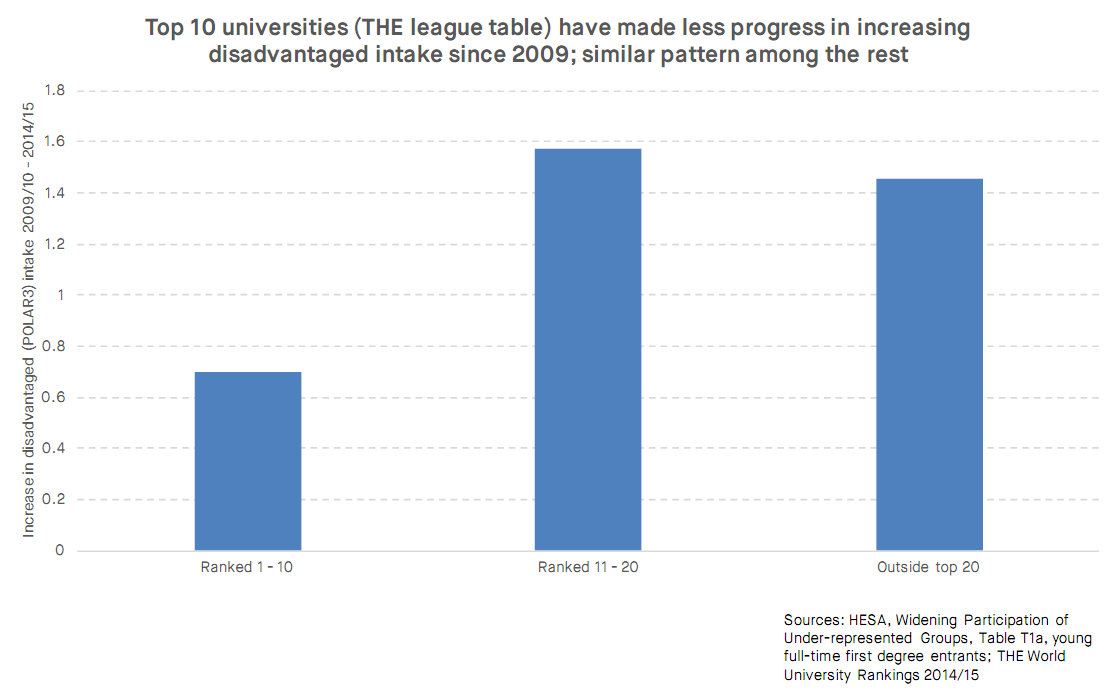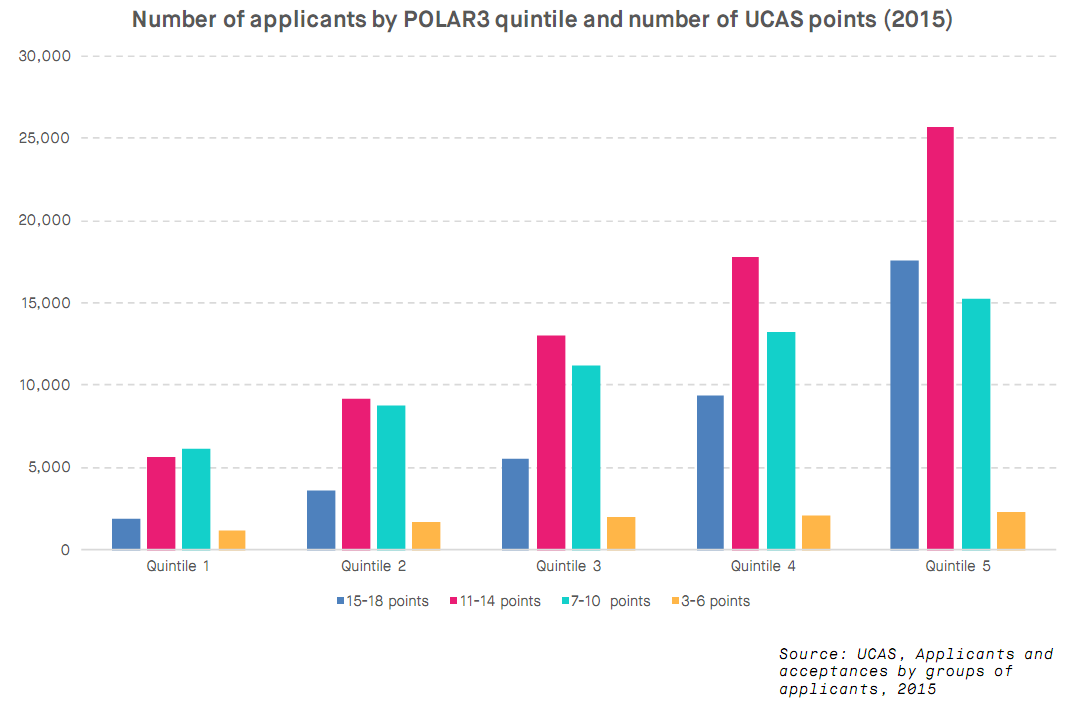 The government has challenged the Higher Education sector to double the proportion of pupils from disadvantaged backgrounds and to raise by 20 per cent the number of undergraduates from Black and Minority Ethnic backgrounds. A report by the Social Market Foundation casts doubt on the achievability of these 2020 goals: we’re on track to do neither. Steve Jones outlines the important findings but challenges some of the solutions on offer.
The government has challenged the Higher Education sector to double the proportion of pupils from disadvantaged backgrounds and to raise by 20 per cent the number of undergraduates from Black and Minority Ethnic backgrounds. A report by the Social Market Foundation casts doubt on the achievability of these 2020 goals: we’re on track to do neither. Steve Jones outlines the important findings but challenges some of the solutions on offer.
Among the observations offered by the Social Market Foundation (SMF) is that the spread of disadvantaged students across UK universities is very patchy. While some institutions’ Widening Participation (WP) intake is pushing 30 per cent, proportions elsewhere barely top 2 per cent. No surprise there, perhaps. But what may come as more of a shock are differences in the rate of improvement. As the SMF graph below shows, progress since 2009 among Top 10 institutions (according to rankings in the Times Higher) is less than half that made by institutions ranked 11-20 and by those outside the Top 20. In other words, the rate at which the UK’s highest prestige universities are growing their WP intake is more sluggish than everywhere else.
Source: Widening Participation Social Market Foundation
Does that matter? Well, as the Social Mobility and Child Poverty commission has noted, the top professions tend to be dominated by alumni of the highest ranking universities. And according to the Sutton Trust, graduates from such universities enjoy the more substantial earnings premium. The risk is that the sector’s uneven distribution of WP students allows social hierarchies to be reproduced and causes social mobility to stall.
The response of selective universities invariably involves locating the problem further down the food chain by arguing the “real” barrier to access is the attainment gap: the difference in the grades with which young people from different socio-economic backgrounds leave school or college. This position is starkly reinforced by UCAS data reported in the SMF report: in 2015, the total number of young people from society’s most disadvantaged quintile holding entry qualifications that placed them in the top attainment bracket was 1,880; however, the total number of young people from the least disadvantaged backgrounds was 17,560. As the graph below shows, the ratio of high-attaining applicants to low-attaining applicants increases exponentially with socio-economic advantage.
Source: Widening Participation Social Market Foundation
One option suggested by the SMF is that “institutions themselves get much more involved in raising prior attainment.” Clearly, there are important ways in which universities could and should work more closely with lower-attaining state schools and colleges. We can ‘inspire’; we can do more to smooth school-to-university transitions; we can ensure that pupils apply to appropriate course and that our admissions processes treat them justly. Research continues to indicate that young people from low-participation backgrounds conceptualise higher-prestige universities as beyond their reach and worry about not fitting in. Selection practices may also disfavour them.
However, it’s another matter entirely to suggest that university staff have the expertise needed to close attainment differentials. The SMF suggests we offer tuition, provide summer courses and “directly take on responsibility for running schools”. However, the pedagogies favoured in higher education – those that develop critical thinking, independent scholarship and research-driven enquiry – are a far cry from the teach-to-the-test model to which schools are increasingly forced to submit.
If the problem is that the highest prestige universities are not pulling their weight in terms of progress with WP, an alternative approach would be for them to become more sensitive to the educational background in which applicants’ grades were achieved and more explicit about how this information is used in admissions processes. Contextual data is not a new idea, but the sector lacks a consistent, transparent policy on how, when and why it is applied. We even have the absurd situation of league tables using entry tariffs as an indicator of institutional quality, thereby incentivising the more elite end of the sector to continue fishing in familiar waters.
Some colleagues express concern that students admitted on the basis of contextual data might not have the skills needed to cope with higher education. But let’s not forget that state school applicants outperform their independent school peers at university on a like-for-like basis. It’s not so much social engineering as rational investment in talent that hasn’t yet had the opportunity to manifest as attainment.
The SMF doesn’t mention admissions. Instead, it turns to market-based solutions, speculating that some new providers may provide a boost to WP. However, as Andrew McGettigan and others remind us, newly-created private colleges have so far been associated more with empty classrooms and suspect business practices than with driving forward the nation’s social mobility agenda.
The job of improving attainment levels among society’s least advantaged groups is deeply specialised, and one that may be better left to trained, time-served professionals than to well-meaning university staff. However, the sector could seek to address social mobility in other ways. Our rankings could reward diversity and inclusivity, not penalise the use of contextual data. Our admissions processes could become more transparent and less gameable. Our teaching could compensate for previous educational shortcomings by offering targeted, sustained support. And we could fixate a little less on prior attainment and the league tables that peddle it.
 Steven Jones is a Senior Lecturer at the Manchester Institute of Education. He blogs at H.E.Watch and tweets as @StevenJones_MCR. He recently published ‘Expression of student debt aversion and tolerance among academically able young people in low-participation English schools’ in British Educational Research Journal. The views expressed here are his own, not his institution’s.
Steven Jones is a Senior Lecturer at the Manchester Institute of Education. He blogs at H.E.Watch and tweets as @StevenJones_MCR. He recently published ‘Expression of student debt aversion and tolerance among academically able young people in low-participation English schools’ in British Educational Research Journal. The views expressed here are his own, not his institution’s.










Contextualising in my opinion should be solely be limited to applicants’ grades but the expectation (particularly of Russell Group universities) of extra-curriculur acheivements such as Duke of Edinburgh, Head Girl, Debating clubs etc. For many students from poor socio-economic backgrounds they need to ‘survive’ and this includes taking on roles within their home (caring for younger siblings or parents) as well as working 20 -30 hours a week in employment, these factors could be given a weight in order to contextualise attainment. Combining studies with these ‘hardship’ factors is not easy and such characteristics of grit and determination are rarely cultivated within private education, but are priceless. However, even when entrance to university has been attained, the barriers to such students continue and internships, often unpaid or underpaid. It is easy to see how this patterns reproduces itself, universities do have responsibilities at both ends of the process.
Thanks for this post Steve.
Having managed to find out that the UCAS tariff score is mapped onto a A*=6, A=5, B=4 etc I can now interpret the 15-18 points (and other) categories in the chart you took form the SMF report. I’ve worked out that the ratios of students from the lowest quintile (most disadvantaged areas) who score up to 3 A*s to the same group from the highest quintile is 1:9.34. Or in other words for every student from a 20% participation neighbourhood that gets in on these grades, over 9 get in from the more advantaged neighbourhoods (if using UCAS tariff scores alone). In a way this reflects the very definition of the Quintiles, but it’s still a shocking result. Repeating this for the next category (11-14 or your BBB students) the ratio drops to 1:4.54. So if you’re from a low-participation neighbourhood the odds of you getting the highest grades (needed for the Russell Groups) is half that of you getting grades that will get you into non-Russell groups (actually much less than half if you then take into account the other 2 categories).
I’m no expert on admissions criteria so I may be off on this last comment, but nonetheless the data are showing a staggering difference, as you note, in supporting the students who are disadvantaged simply by virtue of where they live. And one can only then support the need to consider the contextual data as you suggest. Whether or not this can be done consistently across the escort though is another matter. Universities will surely always seek to exercise the right to interpret this in their own contexts?
Thanks Jackie. I agree that a 1:9.34 ratio in the likelihood of achieving the highest grades is shocking. You’re right to say that universities will seek to exercise complete autonomy when it comes to admissions, but I think there are some areas in which disadvantaged applicants would benefit from a single message from the sector rather than have to navigate multiple institutional voices and policies. Contextual data is one example. Bursaries are another.
What proportion of UK students get A* – B? I thought quite high? Is it a question of whether our face fits?
I think you’re right: to some extent, it is a question of whether the applicant’s face fits, both in terms of admissions and key outcomes. But this is problematic in many ways, and the challenge for more selective universities in particular (because they’re the ones growing their WP intakes most slowly) is perhaps to become clearer about criteria and process.